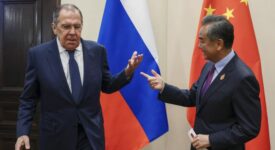Ukraine and the EU: Turning the Association Agreement into a Success Story
Kataryna Wolczuk (European Policy Centre)
The Association Agreement between the European Union and Ukraine may be understood as resulting from two key socio-political events: the Orange Revolution of 2004 and this year’s protests in the Maidan which led to the ousting of President Yanukovich. The former led to the negotiations between Kiev and the EU, and the latter resulted in the signing of the agreement. The deal, which includes the creation of the Deep and Comprehensive Free Trade Area (DCFTA), also commits Ukraine to alter its legal order in line with that of the EU. However, this kind of acquis communautaire is a double edged sword. On the one hand, given the uncertain political and economic situation in Ukraine, implementation of the pledges outlined in the Agreement could prove challenging both logistically and financially. On the other, the Agreement provides Ukraine with a framework to reform and modernise its institutions and create conditions conducive to economic growth.
It is clear that the Association Agreement brings with it several key challenges which the EU should seek to overcome to gain greater access to Ukraine and other Eastern Partnership countries. First, Kiev will have to bear significant short- and medium-term political and economic costs of implementing the Agreement, which will only produce noticeable improvements after some time. Second, Ukraine’s representatives lack the skills and experience necessary to take an active part in negotiations generally within the broader European politics, and specifically with the EU institutions. This problem is then also reflected in the quality and size of Ukraine’s public political discussion. Third, the EU does not reflect the costs of implementing acquis communautaire, and the support it provides to Kiev is insufficient.
These challenges are further complicated by Russia, which repeatedly demonstrated its readiness and willingness to punish Ukraine for its pro-Western stance. What started as a bureaucratic and technical process is therefore gradually becoming a matter of political and geopolitical importance. With a wide variety of tools at its disposal, Russia can take advantage of the shortcomings in the EU’s strategic approach to its Eastern allies. In the Ukrainian context, Kremlin not only exploits Ukraine’s economic and energy dependency but also keeps emphasising the immediate gains Kiev would enjoy as part of the Eurasian Economic Union. Russian realpolitik therefore places further EU enlargement in a new political context. It is in the EU’s interest to reflect upon this development as soon as possible.
(The study can be downloaded here: http://www.epc.eu/pub_details.php?cat_id=3&pub_id=4360)
The Single Market and Cohesion Policy Dyad: Battered by the Crisis and Globalisation
Marjorie Jouen (Notre Europe – Jacques Delors Institute)
The cohesion policy was launched in 1988 as a direct continuation of ‘Objective 92’ and on the basis of arguments of Tommaso Padoa Schioppa, whose report presented the risks of pursuing market integration without parallel progress on macro-economic stability and income redistribution and called for the creation of specific mechanisms to ensure policy cohesion and even distribution of efficiency gains. Following the accession of Central and Eastern European states into the EU, the cohesion policy was modified to reflect the needs of countries and regions with vastly different levels of existing infrastructure, the varying abilities of countries and regions to absorb these financial flows based on their economic profile, and the limits set for the European budget. To maximise the effects of EU funds to less-developed regions, the cohesion policy was subject to relatively strict rules. Together with the single market, the cohesion policy created new export opportunities for less developed countries and regions.
Each Union enlargement has shown that these two mechanisms also acted as a very strong incentive for accession countries. These countries may be divided by foreign investment rates: countries furthest to the East (Bulgaria and Romania in particular) which were excluded from the previous boom and became highly attractive to investors, and their Central and Western European neighbours who had already benefitted from the already established capital flows. However, the economic crisis brought an end to this long period, during which regional disparities in GDP per head and unemployment were gradually being reduced. The halt in regional convergence is chiefly attributable to two simultaneous mechanisms: a) strong synchronisation of economic cycles in regions within the same country regardless of production factors and structural (social, geographic) characteristics, and b) continued growth in high-innovation, densely-populated regions, which left peripheral regions lagging behind. Some experts argue that the cohesion policy was unable to correct the widening gaps across EU Member States. Others view the halted process of convergence as a symptom of the economic crisis, made worse in some Member States by an eastward shift of the EU’s economic core which left the south-west regions in the economic periphery.
New research shows that even the process of globalisation increases the rates of divergence between Member States and, as a consequence, dilutes the effects of the cohesion policy. Its capacity to deliver positive results notwithstanding, the limitation of the single market/cohesion policy dyad lies in the inability to predict future developments. Further criticism of the cohesion policy is aimed at its marginal role compared to the single market. However, one must keep in mind that a successful exit from the crisis will also bring about an effective transition to new ecological and energy models in the European economy. The divorce between the single market and the cohesion policy is therefore a risk which, until now, no one has dared take.
(The study can be downloaded here: http://www.eng.notre-europe.eu/011-18615-The-single-market-and-cohesion-policy-dyad.html)
2004-2014: Review of a Decade of Enlargements
Gilles Lepesant (Robert Schuman Foundation)
The three enlargement waves in 2004, 2007 and 2013 marked an unprecedented territorial growth of the European Union, almost doubling the number of Member States in less than a decade. The accession candidacies and subsequent EU memberships brought to Central European countries a number of positive improvements, most notably in the form of economic stability and a solid legal platform. This was reflected in long-term economic growth in the region and an influx of foreign investors who were additionally motivated by prospects of relatively cheap labour. The advances made in Central Europe in recent years also played a role throughout the financial crisis, when these new EU Member States fared better than ‘old Europe’.
However, despite these improvements, Central Europe continues to face a number of social and political challenges. A number of states like Poland, Slovakia, and Hungary are becoming plagued by populist movements, forcing the European Commission into launching warning measures and infringement procedures in cases where countries fail to respect the European rule of law. Moreover, many Western European countries tend to view the policy of enlargement with suspicion. This distrust stems from two sources: first, cheap labour in new EU Member States could attract Western European companies, which could lead to job destructions in their region of origin.
Yet, according to the available data, few relocations involved Central Europe and the jobs destroyed were barely significant in comparison with the number of jobs created. Above all, these relocations should be added to the new opportunities that major European economies found in Central Europe in terms of investment and exports. Second, it is feared that a wave of westward immigration could choke the region’s economies with cheap labour. However, this effect was significantly reduced by the ‘old’ Members’ decision to use their right to restrict access to their labour market from new Member States for up to seven years.
The above concerns, although not supported by any study, have shaped a new approach to enlargement, which is no longer a major policy since the EU is insisting more than ever before on the respect of the rule of law and on the administrative capabilities of the candidate countries. Attention has turned to the European Neighbourhood Policy, which is viewed as an opportunity to create a vast pan-European market that would allow the free movement of people, goods, services, and capital characteristic of the internal market.
(The study can be downloaded here: http://www.robert-schuman.eu/en/european-issues/0311-2004-2014-a-review-of-10-years-of-enlargements)







